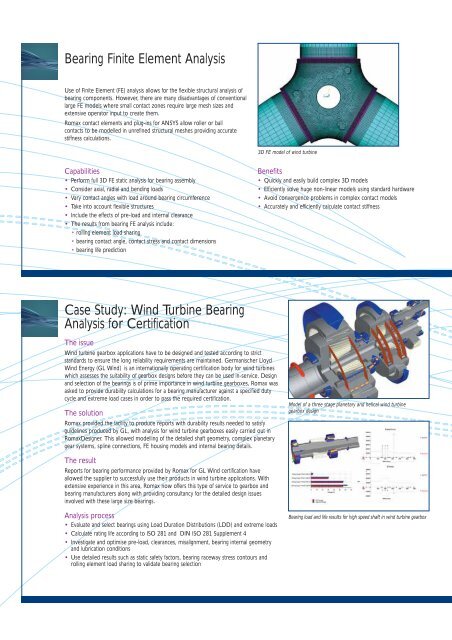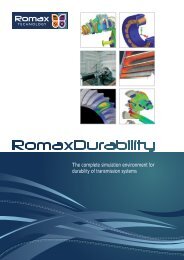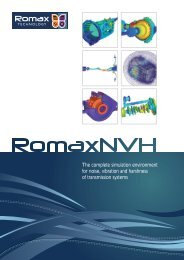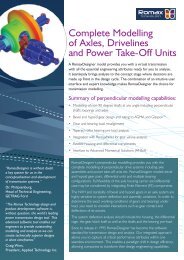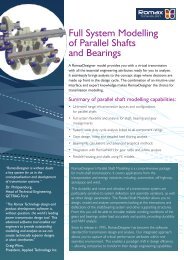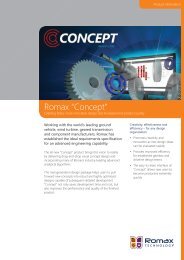Total system approach to advanced bearing technology for ...
Total system approach to advanced bearing technology for ...
Total system approach to advanced bearing technology for ...
You also want an ePaper? Increase the reach of your titles
YUMPU automatically turns print PDFs into web optimized ePapers that Google loves.
Bearing Finite Element Analysis<br />
Use of Finite Element (FE) analysis allows <strong>for</strong> the flexible structural analysis of<br />
<strong>bearing</strong> components. However, there are many disadvantages of conventional<br />
large FE models where small contact zones require large mesh sizes and<br />
extensive opera<strong>to</strong>r input <strong>to</strong> create them.<br />
Romax contact elements and plug-ins <strong>for</strong> ANSYS allow roller or ball<br />
contacts <strong>to</strong> be modelled in unrefined structural meshes providing accurate<br />
stiffness calculations.<br />
3D FE model of wind turbine<br />
Capabilities<br />
• Per<strong>for</strong>m full 3D FE static analysis <strong>for</strong> <strong>bearing</strong> assembly<br />
• Consider axial, radial and bending loads<br />
• Vary contact angles with load around <strong>bearing</strong> circumference<br />
• Take in<strong>to</strong> account flexible structures<br />
• Include the effects of pre-load and internal clearance<br />
• The results from <strong>bearing</strong> FE analysis include:<br />
• rolling element load sharing<br />
• <strong>bearing</strong> contact angle, contact stress and contact dimensions<br />
• <strong>bearing</strong> life prediction<br />
Benefits<br />
• Quickly and easily build complex 3D models<br />
• Efficiently solve huge non-linear models using standard hardware<br />
• Avoid convergence problems in complex contact models<br />
• Accurately and efficiently calculate contact stiffness<br />
Case Study: Wind Turbine Bearing<br />
Analysis <strong>for</strong> Certification<br />
The issue<br />
Wind turbine gearbox applications have <strong>to</strong> be designed and tested according <strong>to</strong> strict<br />
standards <strong>to</strong> ensure the long reliability requirements are maintained. Germanischer Lloyd<br />
Wind Energy (GL Wind) is an internationally operating certification body <strong>for</strong> wind turbines<br />
which assesses the suitability of gearbox designs be<strong>for</strong>e they can be used in-service. Design<br />
and selection of the <strong>bearing</strong>s is of prime importance in wind turbine gearboxes, Romax was<br />
asked <strong>to</strong> provide durability calculations <strong>for</strong> a <strong>bearing</strong> manufacturer against a specified duty<br />
cycle and extreme load cases in order <strong>to</strong> pass the required certification.<br />
The solution<br />
Romax provided the facility <strong>to</strong> produce reports with durability results needed <strong>to</strong> satisfy<br />
guidelines produced by GL, with analysis <strong>for</strong> wind turbine gearboxes easily carried out in<br />
RomaxDesigner. This allowed modelling of the detailed shaft geometry, complex planetary<br />
gear <strong>system</strong>s, spline connections, FE housing models and internal <strong>bearing</strong> details.<br />
Model of a three stage planetary and helical wind turbine<br />
gearbox design<br />
The result<br />
Reports <strong>for</strong> <strong>bearing</strong> per<strong>for</strong>mance provided by Romax <strong>for</strong> GL Wind certification have<br />
allowed the supplier <strong>to</strong> successfully use their products in wind turbine applications. With<br />
extensive experience in this area, Romax now offers this type of service <strong>to</strong> gearbox and<br />
<strong>bearing</strong> manufacturers along with providing consultancy <strong>for</strong> the detailed design issues<br />
involved with these large size <strong>bearing</strong>s.<br />
Analysis process<br />
• Evaluate and select <strong>bearing</strong>s using Load Duration Distributions (LDD) and extreme loads<br />
• Calculate rating life according <strong>to</strong> ISO 281 and DIN ISO 281 Supplement 4<br />
• Investigate and optimise pre-load, clearances, misalignment, <strong>bearing</strong> internal geometry<br />
and lubrication conditions<br />
• Use detailed results such as static safety fac<strong>to</strong>rs, <strong>bearing</strong> raceway stress con<strong>to</strong>urs and<br />
rolling element load sharing <strong>to</strong> validate <strong>bearing</strong> selection<br />
Bearing load and life results <strong>for</strong> high speed shaft in wind turbine gearbox


